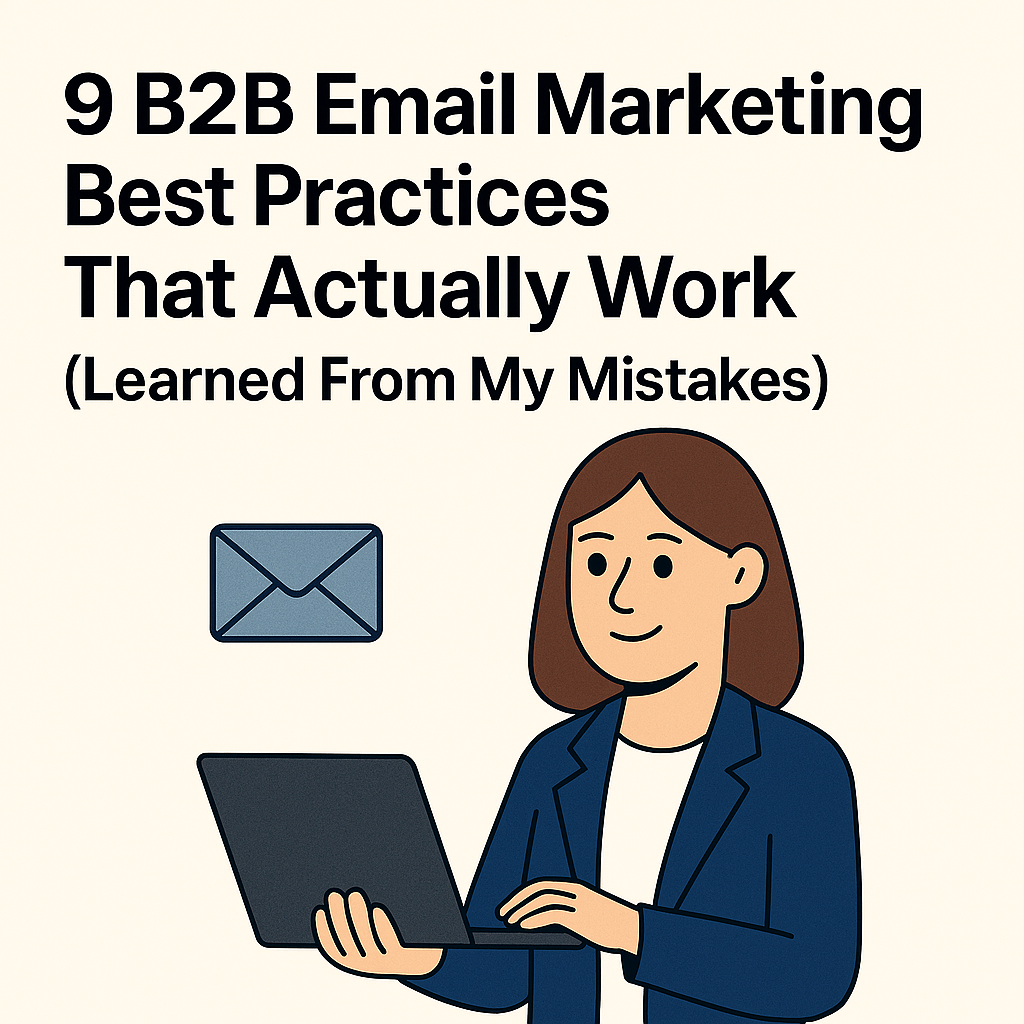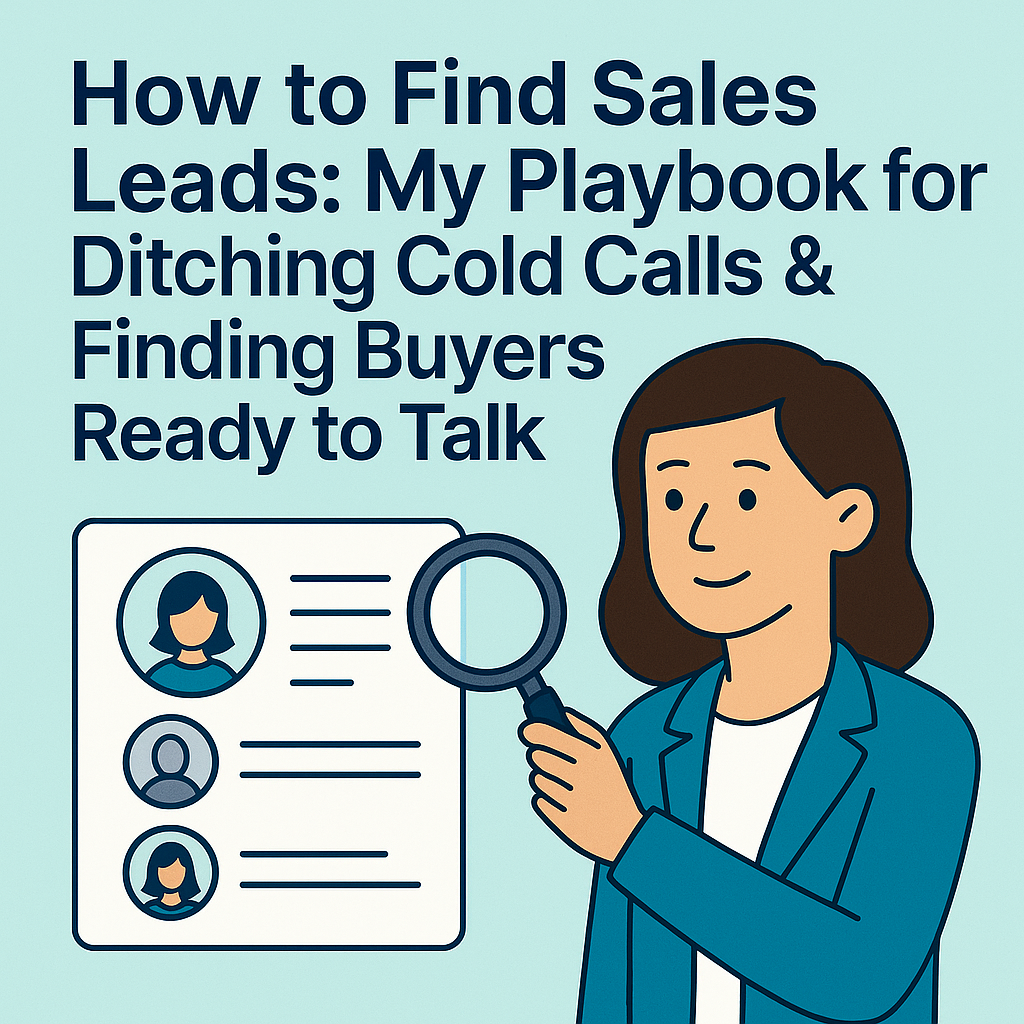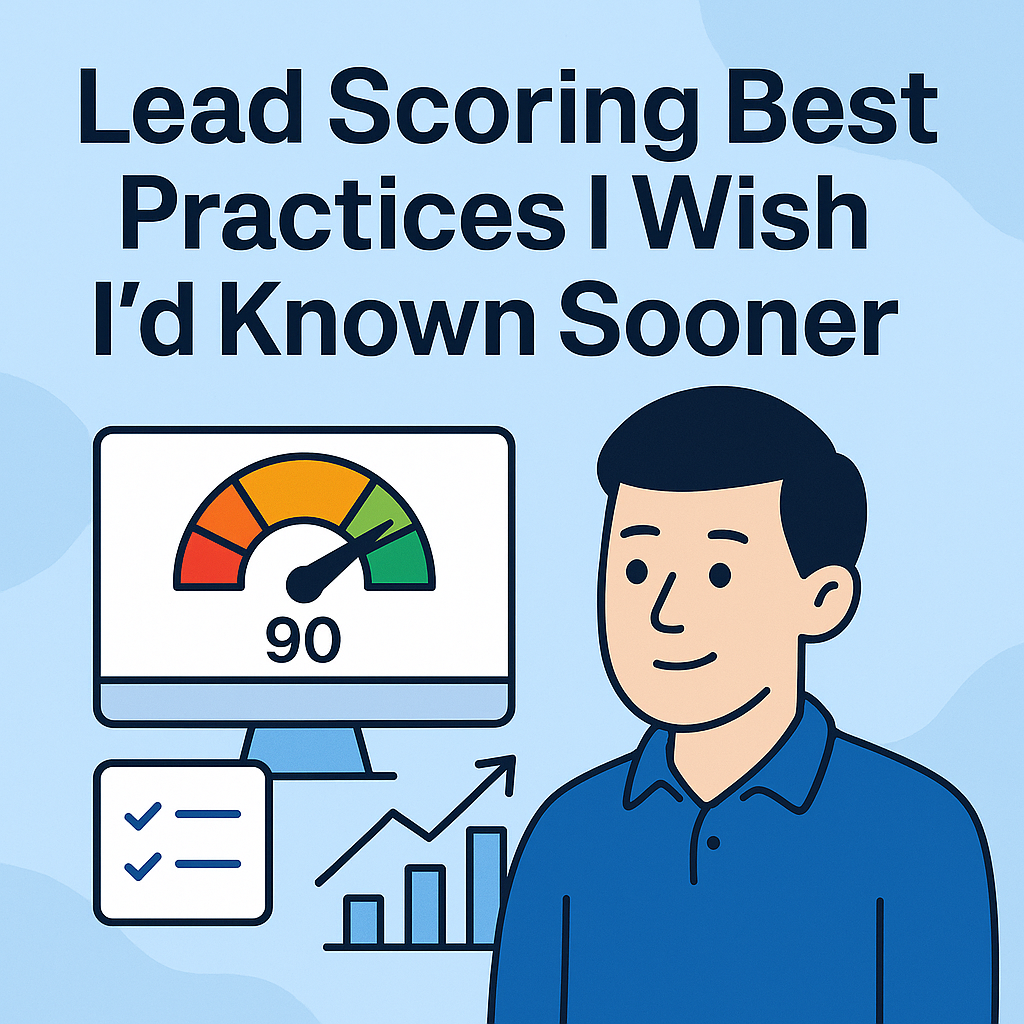Your Ultimate Guide to LinkedIn for Prospecting (and How to Avoid the Cringey Mistakes I Made)
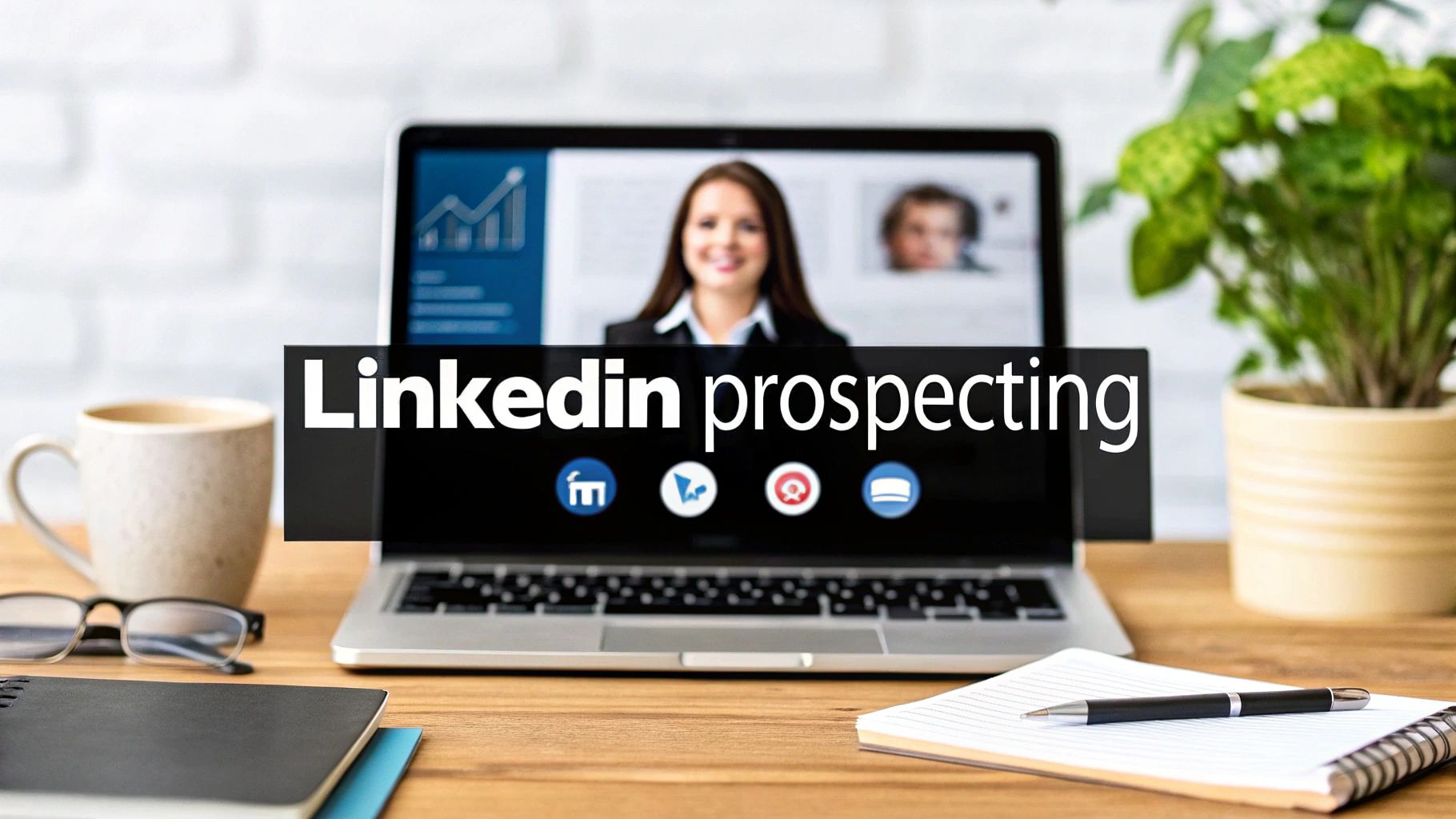
Let's be real. The top sales pros I know? They're living and breathing on LinkedIn. But this isn't about mindlessly scrolling your feed. We're talking about a strategic, relationship-first approach to identifying, engaging with, and genuinely connecting with your dream clients. It’s time to stop shouting into the void and start building a pipeline that works.
Why LinkedIn Is Your Ultimate Prospecting Playground
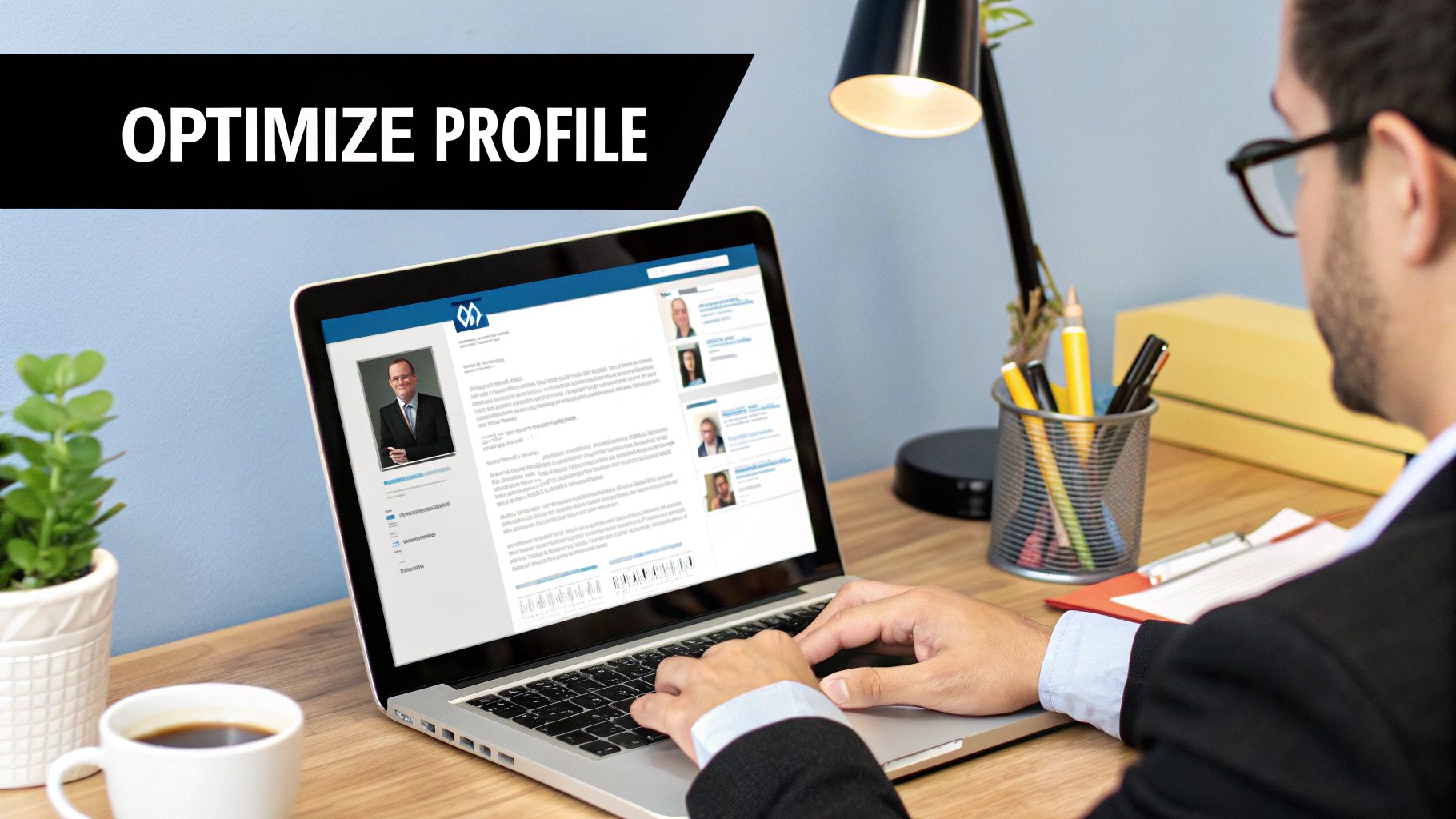
I’ve been there, staring at a silent inbox after sending out dozens of emails, my call list leading straight to a symphony of voicemails. It was soul-crushing. What changed everything for me? I stopped blasting and started connecting. I went all-in on LinkedIn, and it completely transformed my sales game.
Why? Because LinkedIn is the digital town square where your future clients are hanging out, sharing their biggest challenges, and practically raising their hands to signal their needs. It’s a living, breathing ecosystem of opportunity, not just a dusty old database.
My Cringiest (But Most Valuable) Mistake
I still cringe thinking about one of my first big attempts at LinkedIn prospecting. I found the perfect prospect, a VP at a company that was at the top of my dream list. My heart was pounding. In a rush of excitement, I hastily drafted a connection request note that was essentially a copy-pasted sales pitch. It was clumsy, self-serving, and tone-deaf.
The result? Absolute crickets. I didn't just get ignored; I felt like I'd been digitally shunned. I burned that bridge before I even had a chance to build it.
That painful silence taught me the most important lesson in modern sales: LinkedIn prospecting isn't about selling; it's about starting conversations. You have to shift your entire mindset from aggressive pitching to strategic connection-building. Your goal is to become a familiar, trusted voice in your prospect's professional world, not just another notification they dismiss without a second thought.
The Undeniable Power of the Platform
The numbers here are just wild. With over 1 billion users, LinkedIn is the undisputed king of B2B prospecting. That insane reach means you can pinpoint key decision-makers in pretty much any niche you can dream of. 53% of B2B marketers use LinkedIn specifically to find and verify prospects. If you're serious about sales, you wouldn't ignore that. You can see more of these lead generation stats on sopro.io.
But here’s the secret: it's not just about finding people. It’s about understanding them. What are they posting about? What groups are they active in? What business pains are they complaining about publicly? Every single piece of activity is a breadcrumb, a clue that can lead you to a meaningful conversation.
The real magic of LinkedIn for prospecting is turning a stone-cold outreach into a warm, relevant introduction. You get to show up at the right time with the right message because the platform gives you all the context you need.
This is where integrating smart tools becomes a complete game-changer. Imagine knowing the exact moment a target account is ready to buy because they just posted a relevant job opening. With a tool like gojiberryAI, you can automatically track these buying signals. It flags these triggers for you, allowing you to craft a perfectly timed outreach message. This transforms your prospecting from guesswork into a precise, data-driven strategy.
Build a Profile That Pulls Prospects In (Not Pushes Them Away)
Let's be honest: your LinkedIn profile is your digital handshake, your 24/7 sales rep. Does yours scream 'trusted expert,' or does it whisper, '...who is this again?' I'll be the first to admit, my first profile was a carbon copy of my resume, dull, self-centered, and it attracted exactly zero qualified leads. It was a classic rookie mistake.
We're going to fix that right now. The goal is to transform your profile from a static document into a dynamic, client-focused magnet. We want it to pull your ideal prospects toward you.
Your Headline Is Your Billboard
Think of your headline as a billboard on a busy highway. You’ve got about three seconds to grab someone's attention before they speed past. A simple job title like "Sales Director" is a massive, unforgivable missed opportunity. It's boring and tells a prospect absolutely nothing about how you can solve their problems.
Let’s reframe that. Instead of just stating what you are, tell them what you do for them.
- NEVER DO THIS (My old, bad headline): Account Executive at Tech Solutions Inc.
- DO THIS INSTEAD (A client-focused headline): Helping B2B SaaS Founders Secure Their First 50 Enterprise Customers | Pipeline Generation & GTM Strategy
See the difference? The second one immediately speaks to a specific person (B2B SaaS Founders) and nails one of their biggest pain points (getting those first big customers). It’s a mini-value proposition. So, ask yourself: what problem do I solve, and for whom? That's your new headline.
Rewrite Your About Section From Their Perspective
The "About" section is probably the most underutilized piece of real estate on LinkedIn. Too often, it’s just a dry, third-person summary of a career path. I have to break it to you: nobody cares about your career path. Your prospects only care about one thing: WIIFM (What's In It For Me?).
So, it's time for a rewrite. I learned this the hard way after my resume-style "About" section failed to spark a single conversation. Your new mission is to tell a story that resonates with your ideal client's challenges and dreams.
Pro Tip: Structure your "About" section like a mini landing page. Start by hitting on their problem, then introduce your solution (that's you!), and always, always finish with a clear call to action. Invite them to connect, check out a resource, or even book a call.
This simple shift in perspective shows empathy and instantly positions you as a problem-solver. When you make your profile about them, they're far more likely to see you as a valuable connection rather than just another salesperson.
Profile Optimization Do's and Don'ts
Here's a quick cheat sheet to turn your profile from a dusty resume into a lead-gen machine.
Following these guidelines is the first step toward building a profile that isn't static but actively works for you 24/7.
This client-first approach needs to extend into everything you do, especially your outreach. The data below shows a shocking difference in acceptance rates.
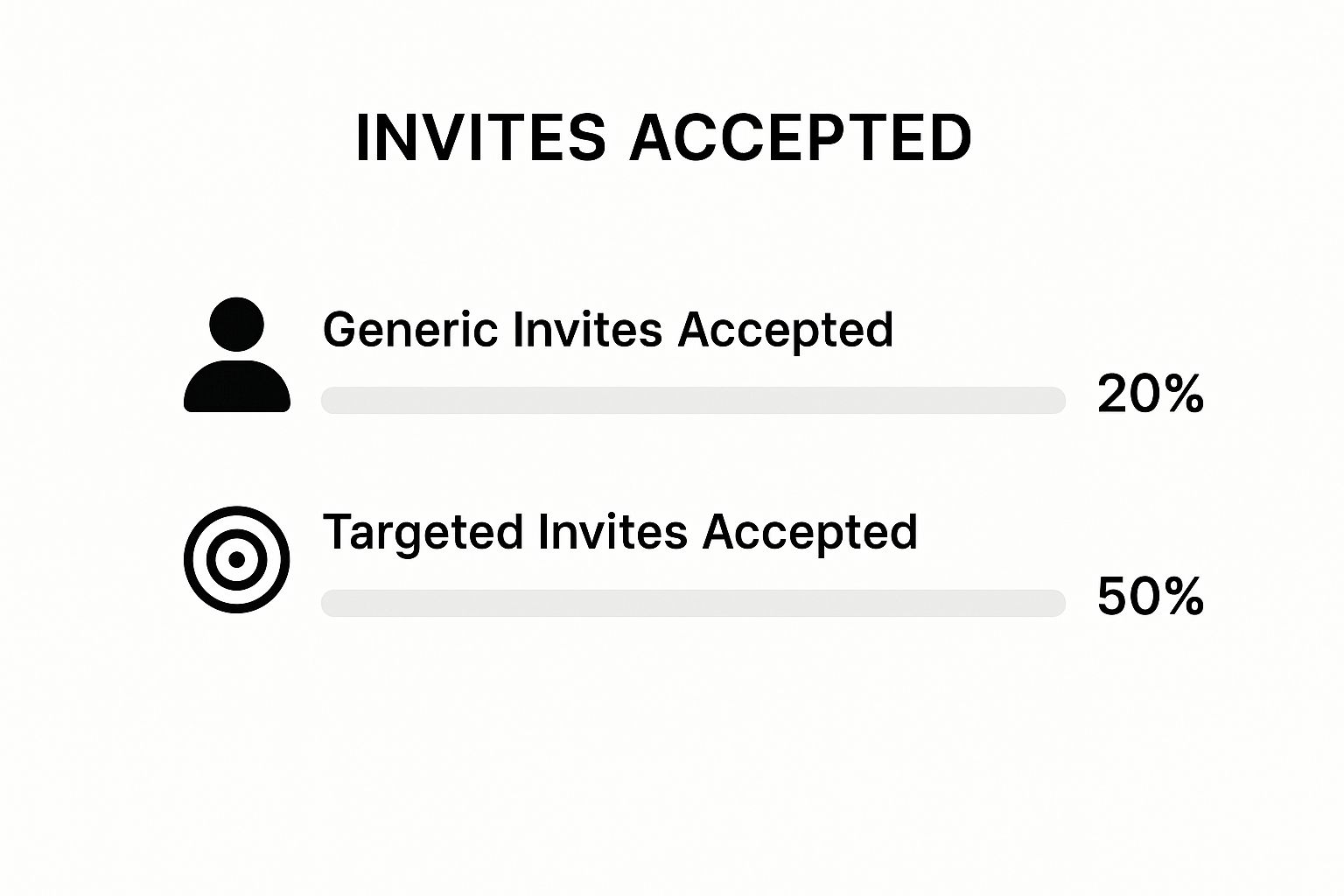
As you can see, personalizing your entire approach, starting with a profile that speaks their language, can more than double your chances of success. A strong profile is also the perfect foundation for using some of the top free LinkedIn lead generation tools to find and engage prospects.
Showcase Your Expertise (Don't Just Talk About It)
Words are great, but proof is so much better. The "Featured" section is your opportunity to visually back up the awesome claims you make in your headline and summary. Whatever you do, ensure it isn't blank!
Here’s what you should be featuring, starting today:
- A link to a compelling case study you wrote
- A post where you shared a valuable industry insight that got great engagement.
- A short testimonial video from a happy client (this is pure gold).
- A link to a webinar you hosted or a podcast you appeared on.
This provides instant social proof and gives prospects a tangible reason to trust you. When they can see real evidence of your skills, you transform from being just another person in their inbox into a credible authority. This is a non-negotiable step in mastering LinkedIn for prospecting.
Mastering the Hunt for Your Ideal Clients

Alright, let's talk about the hunt. LinkedIn is an absolute goldmine of potential clients, but most people approach it with a plastic shovel. Simply typing "Director of Marketing" into the search bar is a recipe for frustration. I know because I've been there. You get a massive, irrelevant list, and it feels completely overwhelming.
The truth is, finding the right people is an art and a science. It’s about being a detective, not just a searcher. You need the right map and the right tools to unearth the real treasure. Ready to become a LinkedIn search ninja?
Beyond the Basic Search Bar
Your first pro move is mastering Boolean search. It sounds super techy, but it’s simple and will make you feel like a wizard. It uses basic commands to tell LinkedIn exactly what you’re looking for.
Here are the essentials you need to know:
- AND: Narrows your search. “Head of Sales” AND SaaS finds people who have both terms in their profile.
- OR: Broadens your search. Sales OR Business Development will show you profiles with either of those titles.
- NOT: Excludes terms. “Marketing Director” NOT Assistant filters out the junior folks, giving you more senior prospects.
- Quotes (" "): Searches for an exact phrase. "VP of Engineering" ensures you don’t get random results for "VP" and "Engineering" separately.
- Parentheses ( ): Combines multiple operators for complex searches. For example, (CEO OR Founder) AND (Fintech OR "Financial Technology").
I once wasted an entire week chasing VPs at software companies, only to realize half were in the wrong sub-industry. A simple string "Vice President" AND (SaaS NOT "On-premise") would have saved me days of work. Don't repeat the same mistake!
Unlocking the Real Power of LinkedIn prospecting with Sales Navigator
If you’re serious about using LinkedIn for prospecting, Sales Navigator isn't just a "nice-to-have"; it's your new best friend. It’s like switching from a blurry pair of binoculars to a high-powered, military-grade telescope.
The real magic is in the advanced filters that 99% of people ignore. These are the ones I use to build hyper-targeted lead lists that feel like cheating:
- Posted content keywords: This is a game-changer. You can find people who have recently talked about a specific problem you solve. Imagine searching for prospects who posted about "scaling sales teams." That's not a lead; that's a massive buying signal.
- Company headcount growth: Are they growing fast? This almost always signals a new budget, new projects, and a desperate need for solutions like yours. A 20% or more growth rate is a fantastic indicator.
- Years in current role: Prospects in their first year at a new leadership role are significantly more likely to shake things up and bring in new vendors. Filter for "Less than 1 year."
By layering these filters, you move from receiving just potential fits to identifying prospects with high, active intent.
The goal isn't just to find people with the right title. It's to find the right people, with the right problem, at the exact right time. This is the heart of effective prospecting.
My Step-by-Step Tutorial for a Killer Lead List
Here’s my exact process. Steal it.
- Define the Trigger: Start by documenting the event that requires your Service. For example, a company just received Series B funding.
- Layer the Filters: In Sales Navigator, I’ll start with the basics: Geography (e.g., United States), Industry (e.g., Computer Software), and Company Headcount (e.g., 51-200).
- Add the Secret Sauce: Now I add the high-intent filters. I’ll search for keywords they've posted ("GTM strategy"), look for recent job changes, and pinpoint companies with high growth rates.
- Save the Search: This is critical. Save your search in Sales Navigator. LinkedIn will then automatically notify you when new people match your perfect criteria. It's like having a lead-gen robot working for you 24/7.
This disciplined approach transforms your LinkedIn for prospecting efforts from a manual chore into a strategic system. It’s a core component of turning social platforms into a predictable sales engine, and is a key part of how you can turn social media into a Sales machine.
Remember, the platform is where the action is. Roughly 80% of B2B leads generated from social media come directly from LinkedIn, solidifying its spot as the top channel for B2B growth.
By mastering search, you're not just finding leads; you're uncovering timely opportunities ready for you to engage.
Crafting Your Outreach and Follow-Up Playbook (That Gets Replies)
You’ve found the perfect prospect. Your profile is sharp. Now what? This is the moment of truth where most prospecting efforts completely crash and burn. Firing off a generic, self-serving pitch is the fastest way to get ignored or, worse, blocked. Trust me, I've been ghosted more times than I can count.
Each silent rejection taught me something. Early in my career, my approach was all about me: "Hi, I'm [My Name], and I sell [My Service]. Can we chat?" The response was… well, there was no response, a complete dead end.
The game truly changed when I stopped pitching and started trying to have a genuine conversation. The goal isn't to close a deal in your first message; it's simply to earn the right to have a conversation.
The Connection Request Golden Rule
First things first: the connection request. My golden rule is simple: always, always, always add a personalized note. Sending a blank request is just lazy. It screams, "You're just another number on my lead list."
So, what does a good note look like?
- NEVER DO THIS: "Hi, I'd love to connect." (This is generic and completely meaningless.)
- ALWAYS DO THIS: "Hi Sarah, I loved your recent post on scaling product teams. Your point about agile pods resonated. It would be great to connect and follow your work."
The "do" example is specific, proves you've done your homework (it took 30 seconds), and makes the request about them. It's a tiny bit of effort that makes a massive difference in your acceptance rate.
Your First Message After They Accept
Success! They accepted your request. Don't immediately celebrate by sliding into their DMs with a sales pitch. That's the equivalent of asking for marriage on the first date; it’s a huge mistake and a major turn-off.
Your first message should be a gentle continuation of why you connected. Acknowledge the connection, then either add value or ask a thoughtful, open-ended question.
My Go-To First Message Framework: "Thanks for connecting, [First Name]. Continuing from my note, that point you made about [Specific Topic] was really insightful. I'm curious, how are you seeing that play out at [Their Company Name]?"
This approach is non-threatening and conversational. It invites a reply without asking for anything. To master this subtle art, review our complete warm DM playbook for LinkedIn, which is packed with more real-world examples.
Designing a Follow-Up Cadence That Doesn't Feel Annoying
Most people give up way too soon. The real magic, and where the deals are made, is in the follow-up. But a good follow-up isn't just "bumping this to the top of your inbox." Each touchpoint has to provide new value. The data shows 32% of reps experienced leads going silent, partly due to weak follow-up strategies. Read more on the state of LinkedIn outreach.
Here’s a simple, multi-touch cadence you can steal and adapt:
- Day 3 (Post-Connection): Engage with their content. Leave a thoughtful, non-salesy comment on one of their recent posts.
- Day 7: Send a DM with a valuable resource. This could be a link to a relevant article, a compelling case study, or a helpful tool.
- Day 14: Ask another insightful question related to their industry, a recent company announcement, or their role.
- Day 21: If you haven't heard back, it's time for a polite closing message. "Hey, seems like now isn't the right time. I'll stop following up, but feel free to reach out if anything changes." This is professional and often receives a response.
This playbook turns cold outreach into a series of warm, value-driven interactions. And when you use a tool like gojiberryAI, you can supercharge this process. Receiving alerts on key buying signals, such as a prospect engaging with a competitor or their company posting a relevant job, gives the perfect, timely reason to reach out at every single step.
Amplify Your Prospecting with GojiberryAI

What if you knew the perfect moment to reach out? Not just a good time, but the exact point when a prospect is most likely to need what you're selling. That's the edge you gain when you bring AI-driven buying signals into your LinkedIn prospecting.
Manual prospecting is a grind. Let’s be honest, it’s a massive time sink. I used to burn hours every week just digging for clues, desperately trying to find a reason to connect that wasn't completely out of the blue. It was exhausting, and the results were out of place.
This is where a tool like GojiberryAI gives you an almost unfair advantage. It completely changes the game from manual searching to automated opportunity discovery.
From Searching to Signal-Based Selling
Think of GojiberryAI as your intelligence agent, working for you 24/7. It scans the digital world for critical buying triggers across your target accounts. Instead of you hunting for these clues, it serves up high-intent signals on a silver platter.
So, what kind of signals are we talking about?
- Hiring Sprees: A company suddenly posts a dozen jobs for a new sales team. That’s a huge tell; they're investing in growth and will need tools and services to support that new function.
- Funding Announcements: Your target just closed a Series B round. This almost always means a new budget has been unlocked, and aggressive growth plans are about to kick off.
- Keyword Mentions: An executive at a key account posts on LinkedIn about a problem you solve, mentioning something like "improving our GTM strategy."
These aren't just random data points; they are your golden ticket. They are your "in" to craft an incredibly relevant and timely message. I once spent two weeks trying to book a meeting with a VP, only to find out later his company had announced a major expansion a month before. If I'd known then, my entire approach would have been sharper and far more likely to succeed.
The heart of modern prospecting is timing. It's not just about reaching the right person; it's about reaching them at the very moment they're actively looking for a solution. AI makes that possible at scale.
A Practical Walkthrough to Using GojiberryAI
Let's get practical. How do you use this to make your prospecting smarter, not harder? Here’s a simple step-by-step tutorial.
- Configure Your Watchlist: First, you tell GojiberryAI which companies you prioritize. Upload your list of target accounts to create your personalized monitoring dashboard.
- Define Your Signals: Next, you tell it what to look for. Are you looking for companies hiring engineers? Or maybe you want to know when a prospect interacts with a competitor's content. You set the rules.
- Receive Real-Time Alerts: GojiberryAI does the heavy lifting, sending you alerts as soon as these triggers pop up. These alerts are enriched with the contact info you need, often delivered right into your CRM.
- Craft the Perfect Outreach: Now for the fun part. You use this intel to craft a killer outreach message on LinkedIn.
Instead of a generic, easily ignored pitch, your message becomes a strategic intervention.
- Generic: "Hi, I help companies like yours. Can I show you a demo?" (We all know where this one is headed: the trash.)
- Signal-Based: "Hi John, saw your team is hiring several new SDRs, congrats on the expansion! We help new sales VPs get their outbound pipeline within the first 90 days. Is that a priority for you right now?"
The second message proves you’ve paid attention, understand their immediate context, and are offering a relevant solution to a timely problem. It’s the difference between a cold message and a warm, strategic introduction.
Your Action Plan for Real Results
Alright, we've covered a ton of ground. You now have the complete playbook, from overhauling your profile and finding the right people to starting real conversations that lead somewhere.
But let's be real: ideas alone don't build a pipeline. It's time to put this to work. This isn't just a summary; this is your launchpad.
Your 30-Day Mission
I'm challenging you: commit to this plan for the next 30 days. No skipping, no excuses. If you stick with it, I guarantee you'll see a massive shift in your prospecting outcomes.
Here’s your daily and weekly mission:
- Daily (15-20 Mins): Find 3-5 posts from people on your target list and engage. And I don't mean leaving a lame "Great post!" comment. Add to the conversation by asking a smart question or sharing a related insight. Show you've read it.
- Weekly (1 Hour): Build one new, laser-focused lead list in Sales Navigator. Get creative with the high-intent filters we talked about. And always, always save that search.
- Daily (15-20 Mins): Send 5-10 genuinely personalized connection requests. Use your new lead lists or act on buying signals from a tool like GojiberryAI. Your message must mention something specific.
- Weekly (1 Hour): Set out time to review your pipeline and follow up. Don't just send a lazy "just checking in" message. Share a relevant article, a case study, or another piece of value.
I learned this the hard way. I used to "binge prospect", spending hours on a Monday sending messages and then ghosting LinkedIn for the rest of the week. It completely killed my momentum. Your greatest advantage is consistency. A little effort every single day is what builds a predictable, powerful sales engine.
That awful feeling of sending connection requests into a void? That ends today. You have a repeatable system designed to fill your calendar with qualified meetings. The only thing left to do is start.
What's your first move going to be?
Frequently Asked Questions
When it comes to using LinkedIn for prospecting, clients have a few questions. Here are the answers I give to Pros who are serious about getting results.
How much time should I spend on LinkedIn every day?
This is a big one. The most common mistake I see, and one I used to make, is "binge-prospecting." You spend hours on a Monday sending requests, then ignore LinkedIn for the rest of the week. It just doesn't work; you lose all momentum.
Consistency is everything. I've found the sweet spot is blocking out 30-60 minutes every single day. Add it to your calendar, as if it's a meeting with your most important client.
Here’s a simple breakdown that gets results:
- 15 minutes: Jump into your feed and engage. Leave thoughtful comments on your prospects' posts. Something that adds to the conversation, not just a "great post!"
- 15 minutes: Send out a handful of new, genuinely personalized connection requests.
- 15-30 minutes: Nurture your existing conversations. Follow up. This is where the real work happens.
This daily rhythm is what turns sporadic effort into a predictable pipeline.
Is Sales Navigator worth the money?
For anyone serious about B2B sales, the answer is a massive YES. I get the hesitation; it feels like just another monthly subscription.
But here’s how I explain it: using the free version of LinkedIn is like trying to fish in the ocean with a single fishing rod. Upgrading to Sales Navigator is like getting the keys to a modern fishing boat with advanced sonar.
The advanced search filters alone are worth the price of admission. When you add in the ability to create dynamic lead lists that update automatically and get real-time alerts on your prospects, it becomes an absolute no-brainer.
Don't think of it as a cost. It’s an investment. If Sales Navigator helps you land just one extra client this year, it has likely paid for itself many times over.
How can GojiberryAI help me with my LinkedIn prospecting?
Think of it as your secret weapon. While Sales Navigator is amazing for finding people and getting basic alerts, GojiberryAI is your specialized intelligence agent that focuses on buying signals. It scans the web for triggers like new funding rounds, hiring surges for specific roles, or even when an executive mentions a keyword you care about. Then it reports these opportunities to you on a silver platter, helping you reach out on LinkedIn with perfect timing and context. It turns a cold "hello" into a hyper-relevant "I saw you're expanding your sales team..." which is a much, much warmer conversation starter.
What are the biggest mistakes to avoid in a connection request?
I've seen some truly cringeworthy connection requests. Most of them commit one of these three cardinal sins that guarantee you'll be ignored.
- Sending the default, blank request. This is the digital equivalent of a limp, unenthusiastic handshake. It tells the other person, "You're just a number on my list, and I couldn't be bothered."
- Pitching your service immediately. Nothing screams "I only want to sell you something" louder than a sales pitch in the connection note. It's aggressive, premature, and just bad form.
- Using vague, generic flattery. Lines like, "I'd love to connect with like-minded professionals," are completely meaningless and get deleted instantly.
The fix is simple: make it about them. Mention a specific article they wrote, a comment they made, or a recent company achievement you saw, perhaps one flagged by a tool like GojiberryAI. Your goal is to start a conversation, not a transaction.
Are you prepared to stop speculating and begin interacting with prospects at the ideal time? Discover how GojiberryAI provides your team with daily, warm leads that have obvious intent to buy. Make prospecting a high-precision, automated process instead of a laborious task. Find out more about GojiberryAI and how sales teams and founders are completing more deals with less work.
More High-Intent Leads = Your New Growth Engine.
Start Now and Get New High Intent Leads DeliveredStraight to Slack or Your Inbox.







